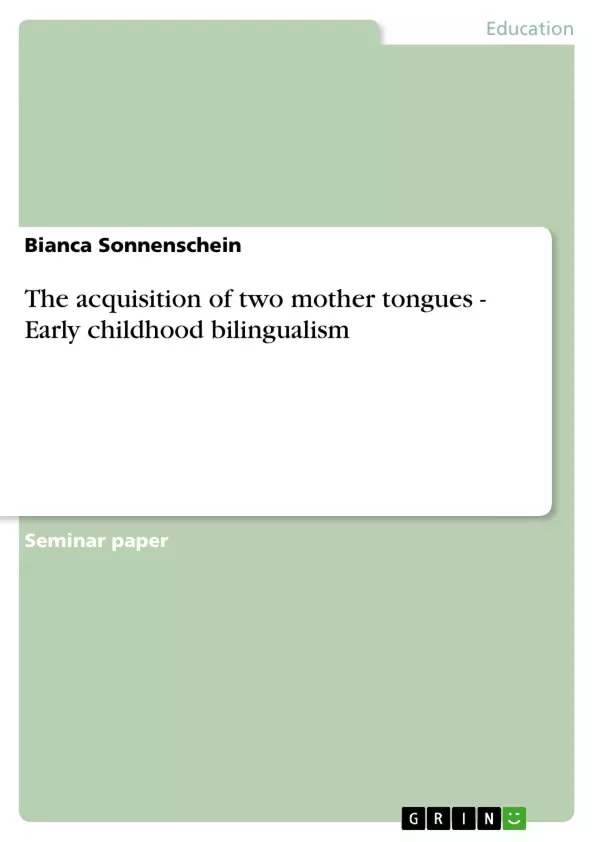The phenomenon of bilingualism is very widespread and a much discussed topic. In reading about it one finds out that there are numerous facets to be considered. While doing research work I wanted to concentrate on childhood bilingualism or “early bilingualism”. When doing so, I found out that I would have to specify my topic for the seminar paper, as even concerning only this part of bilingualism the material I found was overwhelming. My special interest then focused on the aspect of the acquisition of two mother tongues. How exactly does this acquisition take place? How does the child become bilingual? Is it really already in infancy that the child is aware of learning two separate languages or does this awareness rather develop in the process of growing up? Is there a general rule one can refer to when talking about the process of acquiring two mother tongues? These are questions I want to deal with in this paper and to which I will try to find answers.
As the acquisition of two mother tongues nowadays is seen as something positive I first want to have a look at the development of this general opinion. In the next section I want to employ some case studies to show the different strategies of bilingual education and compare them to each other in order to find out if there is a favourable one. Section Four then will deal with the question whether there is only one language system or separate language systems in “early bilingualism.” Finally I want to mention some sociolinguistic aspects referring to childhood bilingualism, such as what factors determine the language choice in children or the phenomenon of interference or code-switching, to be able to draw my own conclusions in section 6.
Inhaltsverzeichnis (Table of Contents)
- Introduction
- The acquisition of two mother tongues / cognitive and educational aspects of bilingualism during the times
- The period of "detrimental effects"
- The period of "neutral effects"
- The period of "additive effects"
- Strategies of bilingual education and their success shown by some case studies
- One person - one language strategy
- One language – one environment strategy
- mixing
- One or two language systems?
- The unitary-language hypothesis
- The separate or independent development theory
- The manifestation of language awareness
- Sociolinguistic aspects of bilingual education
- Language choice in children
- Reasons for interference or code-switching
- Definition of interference
- Definition of code-switching
- Reasons for interference and code-switching
- Conclusion
Zielsetzung und Themenschwerpunkte (Objectives and Key Themes)
This paper aims to investigate the acquisition of two mother tongues in early childhood, exploring its developmental processes, strategies, and sociolinguistic implications. The paper seeks to answer questions about the nature of bilingual development, the awareness of separate languages, and the impact of various educational strategies.
- The historical evolution of perspectives on bilingualism, from detrimental to neutral and finally to additive effects.
- Different strategies for bilingual education and their effectiveness.
- The debate surrounding whether bilingual children develop a single or separate language systems.
- Sociolinguistic factors influencing language choice and the phenomena of interference and code-switching.
- The impact of bilingualism on cognitive and educational development.
Zusammenfassung der Kapitel (Chapter Summaries)
The introduction sets the stage for the investigation of early childhood bilingualism, highlighting the complexities and diverse perspectives surrounding this phenomenon. It outlines the paper's focus on the acquisition of two mother tongues and introduces key questions to be explored.
Chapter 2 delves into the historical development of attitudes towards bilingualism. It examines three distinct periods: the period of "detrimental effects" during the 19th and early 20th centuries, the period of "neutral effects" in the mid-20th century, and the period of "additive effects" emerging in the latter half of the 20th century. This chapter analyzes the influence of research findings, particularly IQ tests, on the prevailing opinions of bilingualism's impact on cognitive development.
Chapter 3 explores various strategies employed in bilingual education, examining their success through case studies. It highlights the "one person - one language" strategy, the "one language – one environment" approach, and the "mixing" strategy, providing insights into their effectiveness and potential benefits and challenges.
Chapter 4 delves into the debate surrounding the development of language systems in early bilingualism. It examines the "unitary-language hypothesis," which posits a single integrated system, and the "separate or independent development theory," which suggests distinct language systems. This chapter also explores the manifestation of language awareness in bilingual children.
Chapter 5 focuses on sociolinguistic aspects of bilingual education, exploring factors influencing language choice in children and the phenomena of interference and code-switching. It examines the definitions and causes of both interference and code-switching, providing insights into their relevance to bilingual development.
Schlüsselwörter (Keywords)
This paper focuses on key themes related to early childhood bilingualism, exploring the acquisition of two mother tongues, cognitive and educational aspects, bilingual education strategies, the development of language systems, and sociolinguistic considerations such as language choice, interference, and code-switching. It further examines the historical evolution of perspectives on bilingualism and the impact of research findings on prevailing opinions.
- Quote paper
- Bianca Sonnenschein (Author), 2003, The acquisition of two mother tongues - Early childhood bilingualism, Munich, GRIN Verlag, https://www.grin.com/document/78073



